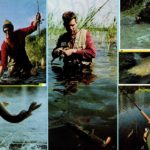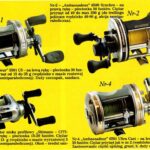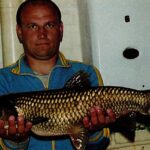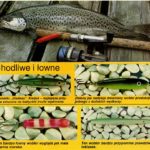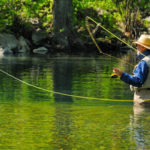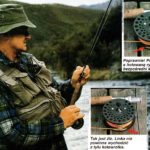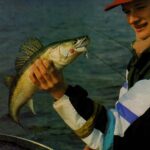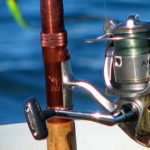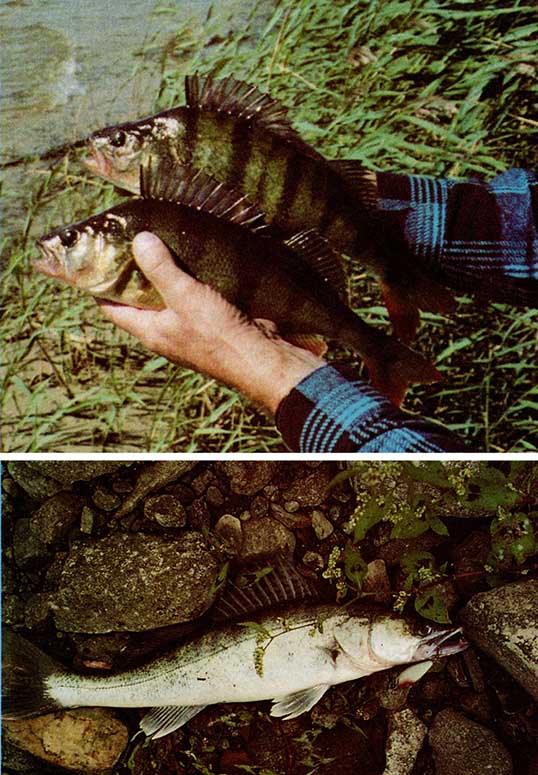 Dla spinningisty pytanie to bywa niekiedy bardzo istotne. Czasami rozpoznanie ryby, która uderzyła w przynętę, stanowi o powodzeniu holu. Inaczej prowadzi się przecież szczupaka, inaczej brzanę. Ten pierwszy zbytnio forsowany lubi stanąć na ogonie, wyskoczyć nad powierzchnię i w powietrzu potrząsać mordą… Ta druga, jeśli w szoku nie została „na sztywno” poprowadzona w górę rzeki, potrafi wysnuć kilkadziesiąt metrów żyłki w ucieczce z prądem…
Dla spinningisty pytanie to bywa niekiedy bardzo istotne. Czasami rozpoznanie ryby, która uderzyła w przynętę, stanowi o powodzeniu holu. Inaczej prowadzi się przecież szczupaka, inaczej brzanę. Ten pierwszy zbytnio forsowany lubi stanąć na ogonie, wyskoczyć nad powierzchnię i w powietrzu potrząsać mordą… Ta druga, jeśli w szoku nie została „na sztywno” poprowadzona w górę rzeki, potrafi wysnuć kilkadziesiąt metrów żyłki w ucieczce z prądem…
Pomysłowość producentów sprzętu nie zna granic. Wymyślono kołowrotki z tzw. hamulcem walki, dodatkowym drągiem pozwalającym na skokową regulację oporu hamulca i powrót do podstawowej wartości hamowania. Nie jest to jednak urządzenie dla wędkarskich indolentów, lecz sprzęt, który może ułatwić życie wyłącznie tym spinningistom, którzy są w stanie po kilku sekundach rozpoznać, co im wisi na żyłce. A wisieć może dużo. Rozwój metody spinningowej poszedł tak daleko, że oprócz ewidentnych drapieżników, zawisają na żyłce ryby, których jeszcze kilka lat temu nikt nie kojarzył z tą techniką połowu.
Dziś zdobyczą dobrego spinningisty padają nie tylko szczupaki, sandacze, okonie i salmonidy, ale także – na zawodach przede wszystkim – jazie i klenie. Wyłącznie na spinning łowi się bolenie. Na obrotówki i woblery nietrudno skusić brzanę, wiosną, po miłosnym wyczerpaniu na drobne przynęty potrafi połakomić się leszcz, duża płoć, a nawet certa czy świnka.
Znam kolegów, którzy w spinningowym szale uparli się, by schwytać na sztuczną przynętę karpia – i robili to z powodzeniem. Na Kanale Żerańskim padł niejeden; bardzo wolno prowadzony wobler w kształcie raka lub krewetki oraz takaż gumka, stały się zgubą dla karpiowych okazów.
Gwałtownicy
Potężne uderzenia i ekscytująca walka, to domena troci i pstrąga. Są to jednak ryby, które nie pozostawiają wędkarzom żadnych wątpliwości – samo uderzenie w przynętę jest bardzo gwałtowne, na ogół tuż po nim następuje raptowny odjazd i charakterystyczne młynkowanie pod powierzchnią. Częste są wyskoki nad wodę, choć duża troć czy potokowiec w głębokich stanowiskach potrafią też przymurować do dna.
Specjaliści od spinningowania w rzekach łososiowych umieją jednak bezbłędnie odróżnić atak troci od szczupakowego pobicia, uderżenie pstrąga od kleniowego puknięcia czy zapięcia się brzany. Szczupak w rzekach Pomorza żyje po sąsiedzku z trocią, ale jest on głównie gwałtownikiem nizin. Mniejsze osobniki, takie do dwóch kilogramów, też nie pozostawiają na ogół najmniejszych wątpliwości. Samo pobicie nie jest specjalnie mocne, aczkolwiek nie przypomina w niczym zaczepu i prawie natychmiast po nim rozpoczyna się ostra walka. Ostra, aczkolwiek esox jest bodaj najbardziej leniwą rybą polskich wód. Atakuje z przyczajki i jak najmniejszym kosztem stara sę uwolnić. Tuż po zacięciu nie chce mu się uciekać – pewnie uważa to za zbyt męczące – i próbuje „na stojąco” wytrząść przynętę z pyska. Jedynie najmniejsze, tzw. podwymiarki, rzucają się do panicznej ucieczki. Pozostałe zapierają się na krótszą czy dłuższą chwilę i szarpią paszczęką – a nuż uda się bez szczególnej mitręgi uwolnić z niemiłej sytuacji…
I tu dość istotna uwaga – po to, by rozpoznanie zapiętej ryby było w ogóle możliwe, należy unikać pospolitego błędu popełnianego przez spinningową brać: po zacięciu zamiast zatrzymać zwijanie żyłki, większość kolegów zaczyna kręcić korbą z pasją zięcia, któremu teściowa kazała zmielić wieprzowinę na kotlety. Takie postępowanie wyklucza rozpoznanie tego, co wisi wędkarzowi…
Po udanym zacięciu, należy na moment przestać kręcić. To chwila na świadomy dialog z rybą. Szczupak natychmiast przyznaje się do tego, że jest szczupakiem – na jeziorze, w rzece, ba, nawet w rwącej strudze będzie szarpać mordą, póki nie pojmie, że nie da się wypluć tego kłopotu bez wysiłku. Dokładnie to samo będzie czynić półmetrowy glut oraz stucentymetrowy krokodyl, chociaż „waga” tych szarpnięć będzie zupełnie inna. Najbardziej gwałtowne uderzenia w przynętę w rzekach nizinnych są domeną bolenia. Nie na darmo ochrzczono go mianem łososia dla ubogich. Rozpisywać się na temat boleniowego walnięcia nie ma sensu, bowiem jest rybą, na którą poluje się w najbardziej świadomy sposób i niezwykle rzadkie są przypadki, by na bardzo szybko prowadzoną przynętę skusił się inny drapieżnik. Rapa jednak bywa niekiedy nieobliczalna i potrafi zaatakować powoli prowadzony twister, ripper czy nawet sporą wahadłówkę. Przedstawia się natychmiast – umie wyrwać kij zbyt lekko dzierżony w wędkarskiej dłoni, umie spowodować upadek łowcy. Nagłe, potężne pobicie może wywołać u wędkarza szok i spowodować utratę równowagi.
